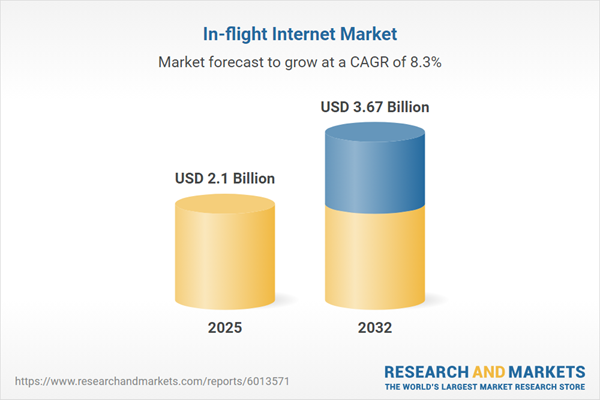Speak directly to the analyst to clarify any post sales queries you may have.
As digital transformation accelerates across aviation, in-flight internet has become an essential pillar for both passenger expectations and airline operational efficiency. Airlines seeking to remain competitive must now leverage advanced aviation connectivity to deliver differentiated value for travelers and stakeholders alike.
Market Snapshot: In-Flight Internet Market Size and Growth Trajectory
The global in-flight internet market is forecast to reach USD 2.10 billion in 2025, rising from USD 1.93 billion in 2024, with expansion anticipated through USD 3.67 billion by 2032 at a compound annual growth rate (CAGR) of 8.34%. Investments by airlines and technology providers are driving enhanced digital engagement and supporting airline operations. As airlines focus on modernizing their digital offerings, they increasingly implement advanced connectivity platforms to create improved customer experiences and strengthen brand differentiation. Current developments in digital adoption prompt airlines and suppliers to innovate solutions that respond to evolving requirements from passengers and operators.
Scope & Segmentation of the In-Flight Internet Market
This report delivers strategic analysis for leadership teams overseeing aviation digital transformation, procurement, and connectivity alignment. The segmentation covers key components that directly influence performance and competitive positioning:
- Connectivity Types: Analysis compares Air To Ground and Satellite approaches, considering differences in stability, bandwidth availability, and worldwide network reach across various operational needs.
- Aircraft Types: Narrow Body, Regional Jet, and Wide Body aircraft are reviewed, emphasizing technology integration for both new manufacturing and retrofit opportunities, while addressing diverse operating requirements.
- Service Offerings: The report evaluates Advertising Supported, Pay Per Use, and Subscription models, connecting these strategies to passenger engagement potential, ancillary revenue growth, and adaptation for specific cabin and route characteristics.
- Deployment Types: OEM and Retrofit implementation routes are assessed regarding cost efficiency, rollout timelines, and adaptability for different fleet compositions, aiding buyers in determining suitable connectivity upgrades.
- Traveler Classes: Business, Economy, First, and Premium Economy segments are explored for their preferences in digital services, supporting targeted enhancements and revenue maximization.
- Regions Covered: The Americas, Europe, Middle East & Africa, and Asia-Pacific are examined to explain regional variation in regulation, infrastructure investments, and market adoption for in-flight connectivity technologies.
- Key Vendors Profiled: Detailed insights for Panasonic Avionics Corporation, Viasat Inc., Thales S.A., Gogo Inc., Inmarsat plc, Intelsat S.A., Hughes Network Systems LLC, SITAONAIR SAS, SmartSky Networks Inc., and OneWeb Ltd enable informed strategic supplier decisions.
In-Flight Internet Market: Key Takeaways for Decision-Makers
- Connectivity platforms act as differentiators for airline brands, supporting strategic alignment with evolving passenger demands.
- Integrating both Air To Ground and satellite connectivity improves consistency and availability for long-haul and cross-regional flight paths.
- Collaboration among airlines, technology vendors, and systems integrators streamlines compliance and simplifies integration issues across diverse global fleets and regulatory settings.
- Segmented digital service offerings, customized for aircraft types and traveler demographics, unlock additional value streams and elevate the overall customer journey.
- Ongoing advancements in cyber security and automated network management enhance operational resilience, equipping airlines to adapt to new challenges in aviation connectivity rapidly.
Tariff Impact: Navigating New U.S. Trade Policies
Recent U.S. tariffs on connectivity hardware have shifted procurement decisions and supply chain strategies for airlines and manufacturers. To offset increased costs and potential project delays, organizations are exploring nearshoring alternatives and broadening their base of suppliers. Active engagement with trade groups and regulators is central to pursuing regulatory exemptions vital to avionics deployment. Robust supply chain management and contingency planning have gained importance to protect business continuity in connectivity investment and rollout cycles.
Methodology & Data Sources
Findings in this report are based on direct interviews with aviation and technology executives, quantitative data analysis, and extensive regulatory review. Additional confidence is provided by intellectual property research and participation in industry workshops, supporting senior management in evaluating market trends.
Why This Report Matters
- Enables executives to benchmark procurement and technology initiatives with evidence-based analysis of aviation connectivity market trends.
- Informs strategic leadership by supplying objective intelligence for partner selection, entry to global and regional markets, and positioning adjustments.
- Supports dynamic response to changing supply chain and compliance contexts, aiding resilient capital planning and operational execution within the in-flight internet sector.
Conclusion
Maintaining a robust position in the in-flight internet market requires adaptable strategies and alignment with industry imperatives. This report provides actionable intelligence to guide executive teams in optimizing aviation connectivity investments for sustainable organizational performance.
Additional Product Information:
- Purchase of this report includes 1 year online access with quarterly updates.
- This report can be updated on request. Please contact our Customer Experience team using the Ask a Question widget on our website.
Table of Contents
3. Executive Summary
4. Market Overview
7. Cumulative Impact of Artificial Intelligence 2025
Companies Mentioned
The companies profiled in this In-flight Internet market report include:- Panasonic Avionics Corporation
- Viasat Inc.
- Thales S.A.
- Gogo Inc.
- Inmarsat plc
- Intelsat S.A.
- Hughes Network Systems, LLC
- SITAONAIR SAS
- SmartSky Networks, Inc.
- OneWeb Ltd
Table Information
| Report Attribute | Details |
|---|---|
| No. of Pages | 186 |
| Published | October 2025 |
| Forecast Period | 2025 - 2032 |
| Estimated Market Value ( USD | $ 2.1 Billion |
| Forecasted Market Value ( USD | $ 3.67 Billion |
| Compound Annual Growth Rate | 8.3% |
| Regions Covered | Global |
| No. of Companies Mentioned | 11 |









